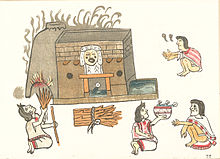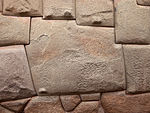Temazcal
This articleneeds additional citations forverification.(December 2008) |

Atemazcal[temasˈkal]is a type ofsweat lodge,which originated with indigenous peoples inMesoamerica.The termtemazcalcomes from theNahuatllanguage, either from the wordsteme(to bathe) andcalli(house),[1]or from the wordtemāzcalli[temaːsˈkalːi](house of heat).[citation needed]
Overview
[edit]
In ancient Mesoamerica it was used as part of a curative ceremony thought to purify the body after exertion such as after a battle or a ceremonial ball game.[citation needed]It was also used for healing the sick, improving health, and for women to give birth.[citation needed]It continues to be used today in Indigenous cultures ofMexicoandCentral Americathat were part of the ancientMesoamerican regionfor spiritual healing and health enrichment reasons.[citation needed]
The temazcal is usually a permanent structure, unlike sweat lodges of other regions. It has various construction styles differing by region; fromvolcanicrock andcementadobe mud bricks even wood mud and cloth can be utilized.[citation needed]It may be a circular dome made to represent the uterus, although rectangular ones have been found at certainarcheologicalsites[which?]and this shape is also used. To produce steam, water is poured over heated volcanic stones, which will not crack and explode like other rocks in confined high temperature areas. The stones may be heated with fire from an outside port or placed in a pit located in the center or near a wall of the temazcal.
See also
[edit]Notes
[edit]- ^Mikkel Aaland."Origin of the Temescal".Archived fromthe originalon 2011-07-08.Retrieved2011-05-04.
External links
[edit]- Article on Temazcal(in English)
- Article on Oaxacan Temazcal

